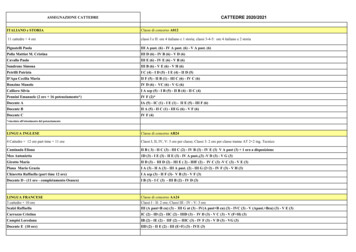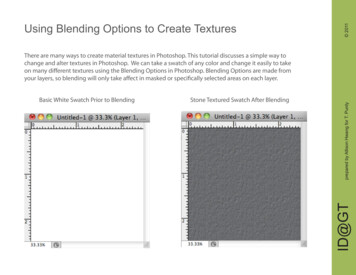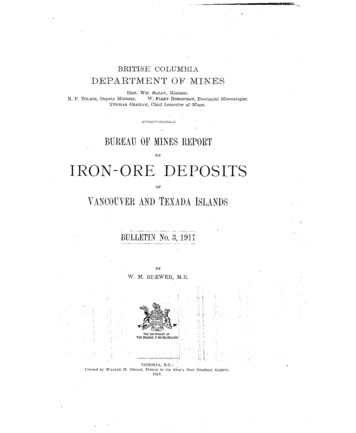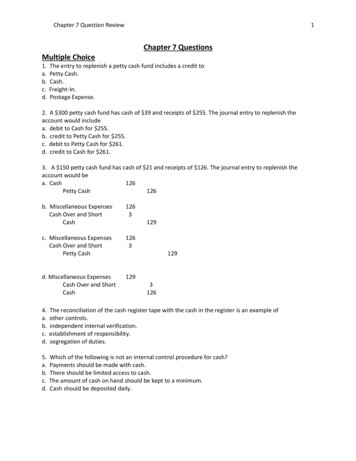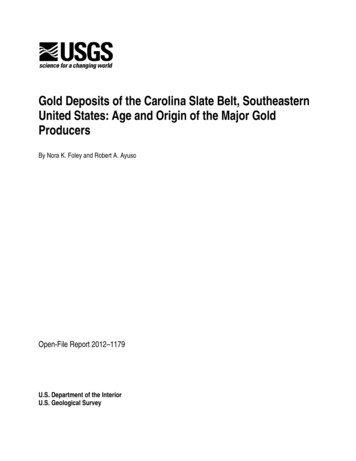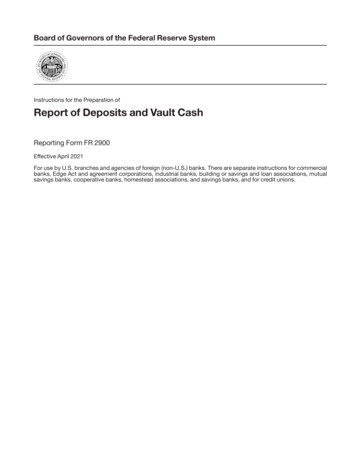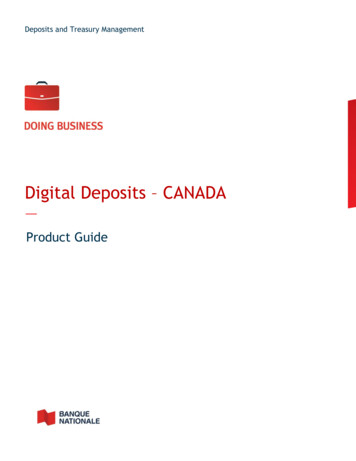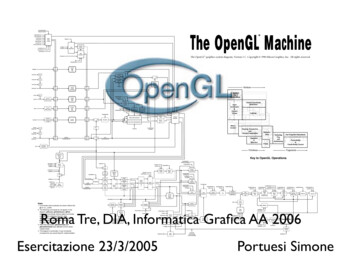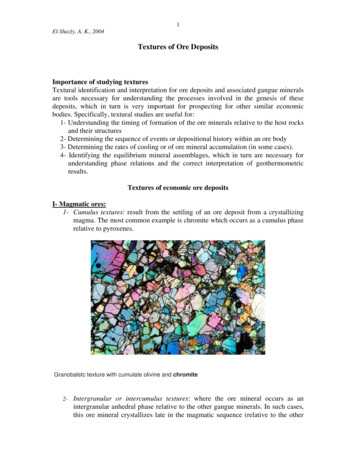
Transcription
1El-Shazly, A. K., 2004Textures of Ore DepositsImportance of studying texturesTextural identification and interpretation for ore deposits and associated gangue mineralsare tools necessary for understanding the processes involved in the genesis of thesedeposits, which in turn is very important for prospecting for other similar economicbodies. Specifically, textural studies are useful for:1- Understanding the timing of formation of the ore minerals relative to the host rocksand their structures2- Determining the sequence of events or depositional history within an ore body3- Determining the rates of cooling or of ore mineral accumulation (in some cases).4- Identifying the equilibrium mineral assemblages, which in turn are necessary forunderstanding phase relations and the correct interpretation of geothermometricresults.Textures of economic ore depositsI- Magmatic ores:1- Cumulus textures: result from the settling of an ore deposit from a crystallizingmagma. The most common example is chromite which occurs as a cumulus phaserelative to pyroxenes.Granobalstc texture with cumulate olivine and chromite2- Intergranular or intercumulus textures: where the ore mineral occurs as anintergranular anhedral phase relative to the other gangue minerals. In such cases,this ore mineral crystallizes late in the magmatic sequence (relative to the other
2El-Shazly, A. K., 2004gangue minerals) so takes up the shape of the intergranular spaces left behind.Examples include numerous sulfides, in many cases crystallizing from liquidsimmiscible with, and of lower melting point than the silicate magma. \Orthocumulate texture - Harzburgite with cumulate olivine and chromite3- Exsolution textures: Where one phase separates from another as a result ofincomplete miscibility during cooling, and has a tendency to concentrate alongcertain crystallographic directions (e.g. cleavage planes). Examples include theoccurrence of ferrian ilmenite in titanohematite or ilmenite in ulvospinel.Exsolution textures usually indicate a slow or intermediate cooling rate. In somecases, exsolution textures are difficult to tell apart from some textures that formby replacement.Chalcopyrite blebs near the vein are a texture known as "chalcopyrite disease”
3El-Shazly, A. K., 2004Sphalerite (light grey) with abundant inclusions of chalcopyriteBIFII- Textures of hydrothermal ore deposits and skarns:A- Replacement textures:
4El-Shazly, A. K., 2004Replacement is the process of almost simultaneous solution and deposition by which anew mineral of partly or totally different chemical composition may grow in the body ofan old mineral or mineral aggregate. According to this definition, replacement isaccompanied by very little or no change in the volume of the rock. However, in practice,this process is accompanied by expansion or contraction (and it has proven quitechallenging to write balanced chemical reactions representing replacement textures inwhich the volume of the products and reactants is the same!). Replacement is morecommon at high T and P where open spaces are very limited or unavailable, and fluidflow is rather difficult. It also depends largely on the chemical composition and reactivityof both the host rock and the hydrothermal solution.In general, it has been observed that certain minerals replace others preferentially.Accordingly, a set of "rules" has been proposed:a) Sulfides replace gangue or ore minerals
5El-Shazly, A. K., 2004
6El-Shazly, A. K., 2004b) Gangue minerals replace host rock, but not the ore mineralsc) Oxides replace host rock and gangue, but rarely replace sulfides.Criteria for identifying replacement textures:1) Pseudomorphs.2) Widening of fractures (Fig. 1).3) Vermicular unoriented intergrowths (Fig. 2).4) Islands (of the host or replaced mineral) having the same optical orientation andsurrounded by the new mineral (Fig. 3).5) Relicts (Fig. 4).6) Cusp and caries texture: (host or replaced mineral). Cusps are relict protuberancesof the replaced mineral or host rock between “caries”. The caries are embayedsurfaces concave towards the replacing mineral into the replaced one (Fig. 5).7) Non-matching walls of a fracture. This is a feature common when replacementworks outward from a central fissure (compare with open space filling textures)(Fig. 6).8) The occurrence of one mineral crosscutting older structures.9) Topotactic and epitactic replacement: Topotaxy is a process where the replacingmineral overgrows the replaced one along certain crystallographic directionscontrolled by the structure of the replaced mineral. Epitaxy is the same processexcept that the structure of the replacing (new) mineral is not controlled by thereplaced mineral, but instead by other "matrix" minerals.10) Selective association: Since replacement is a chemical process, specific selectiveassociations of pairs or combinations of minerals can be expected. For example,chalcopyrite is more likely to replace bornite by a change in the Cu/Fe ratio or infS2 than it is to replace quartz. Therefore, the occurrence of minerals with somechemical similarity in some textural relationship is often a good indication ofreplacement (Fig. 7).11) The presence of a depositional or paragenetic sequence in which minerals becomeprogressively richer in one or more elements (Fig. 8).12) Gradational boundaries: In contrast to open space deposition which produces abrupttextures and structures between the hydrothermally deposited minerals and theirhost rocks, replacement is often accompanied by gradational boundaries betweenboth minerals. Accordingly, gradational boundaries are a good indication ofreplacement.13) Deposition of one or more hydrothermal minerals along a clear alteration front.14) Doubly terminating crystals: If a crystal grows within an open cavity, it is normallyattached to one of the walls of the fracture, and can develop crystal faces only on theother end (i.e. the one away from this wall). In contrast, the process of replacementmay result in the growth of euhedral crystals with well developed faces on morethan one end.15) The lack of offset on a fracture intersected by the replacing mineral: In contrast toopen space filling which may be associated with displacement of a preexisting
7El-Shazly, A. K., 2004structure by the fracture being filled by hydrothermal fluids, replacement across apreexisting structure will not be accompanied by such offset. The same holds truefor two intersecting fractures (Fig. 9).B- Open space filling texturesOpen space filling is common at shallow depths where brittle rocks deform by fracturingrather than by plastic flow. At these shallow depths, ore bearing fluids may circulatefreely within fractures, depositing ore and gangue minerals when sudden or abruptchanges in P and/or T take place. As such, open space filling textures will be differentfrom those resulting from replacement, and a set of criteria may be used to identify thisprocess. Nevertheless, many hydrothermal ore deposits form by the combined effects ofreplacement and open space filling, which requires a lot of caution in texturalinterpretation.Criteria for identifying open space filling processes:1- Many vugs and cavities2- Coarsening of minerals from the walls of a vein to its centre3- Comb structure: Euhedral prismatic crystals growing from opposite sides of afissure symmetrically towards its centre develop an interdigitated vuggy zonesimilar in appearance to that of the teeth of a comb (Fig. 10).
8El-Shazly, A. K., 20044- Crustification: Crustification results from a change in composition and/orphysicochemical conditions of the hydrothermal solution, and is represented bylayers of different mineralogies one on top of the other.567-Symmetrical banding (Figs. 10 & 11)Matching walls: If an open fissure has been filled without replacement, the outlinesof opposite walls should match (Fig. 10).Cockade structure: Mineralization within the open spaces of a breccia or any otherfragmental rock will commonly produce a special pattern of symmetrical bandingand crustification where each opening acts as a centre for sequential deposition (Fig.12).
9El-Shazly, A. K., 2004
10El-Shazly, A. K., 20048-Offset oblique structures (Fig. 13)In addition to replacement and open space filing textures, very low temperaturehydrothermal deposits (epithermal and telethermal deposits) are often characterized bycolloform habits (Fig. 14) and banding described in the following section.III- Textures characteristic of surfacial or near surface environments and processes:Under surfacial conditions, ore minerals may be deposited from colloidal solutions. Acolloid is defined as a system consisting of two phases; one diffused in the other.Colloidal particles range in size between ions in a true solution and particles that are 10-3 cm in a coarse suspension. The colloidal material may be solid, liquid or gasdispersed in another solid, liquid or gas.Colloidal solutions believed to be responsible for the formation of ore deposits usuallyconsist of solids dispersed in liquids and are called "sols". In such sols, colloidal particlescommonly adsorb either cations or anions, and thus acquire similar charges which causethem to repel each other, preventing them from coagulation. If an electrolyte is added tosuch a sol, the colloidal particles are neutralized and flocculate giving rise to a variety oftextures which include:a) Botryoidal or reniform aggregatesb) Banding or very fine layering
11El-Shazly, A. K., 2004c) Leisegang ringsThese textures are broadly lumped as "colloform" textures (Figs. 14 & 15). Becausesome colloform textures were observed in some hydrothermal deposits, it was believedthat some hydrothermal solutions were colloids. However, fluid inclusion analysisshowed that hydrothermal solutions are too saline to have been in the colloidal state, andthe term "colloform" should be considered descriptive and non-genetic.In the surfacial environment, colloidal solutions are common. Criteria used to identify acolloform texture as a product of deposition from a colloidal solution include:1)2)3)4)5)Shrinkage cracks: which develop due to dehydration of a gelLiesegang rings: Are coloured bands that form when an electrolyte is allowed todiffuse into a gel. Liesegang rings are common in amorphous, cryptocrystalline andmicrocrystalline "minerals" or mineraloids as agate and opal.Variable composition of bands and/or deposits: This phenomenon is due to theability of colloids to adsorb different ions from their surroundings.Non-crystalline structure: The occurrence of amorphous "minerals" or mineraloids(e.g. opal) is an indication of formation from a colloidal solution. However, suchmineraloids will tend to crystallize with time.Spheroidal texture: Are rounded objects similar to pisolites, which result from thelow surface tension of a colloid.
12El-Shazly, A. K., 2004
Textural identification and interpretation for ore deposits and associated gangue minerals are tools necessary for understanding the processes involved in the genesis of these . 3- Determining the rates of cooling or of ore mineral accumulation (in some cases). 4- Identifying the equilibrium mineral assemblages, which in turn are necessary .

